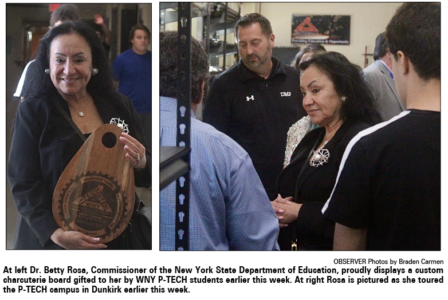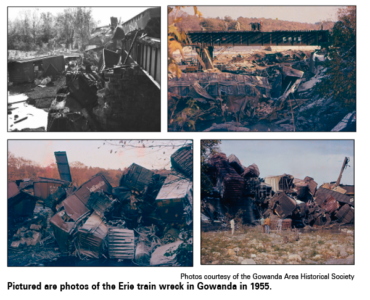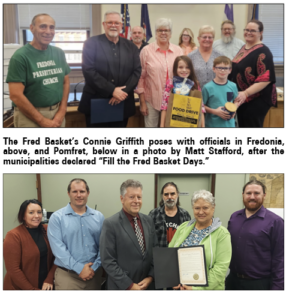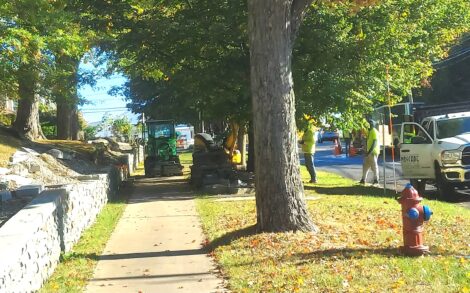Gowanda 1955 train wreck derailed traffic for days
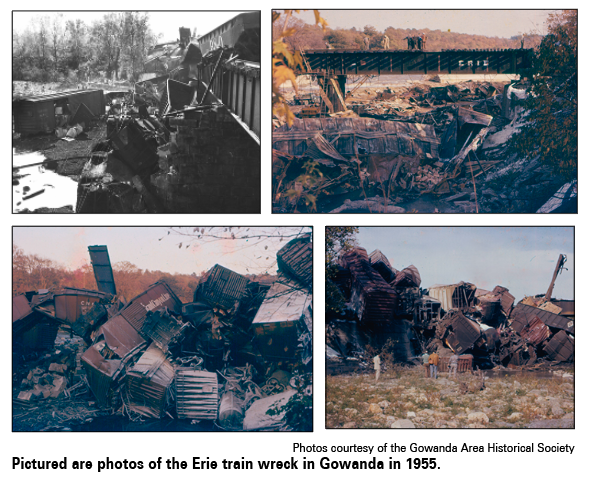
Seventy years ago, on Oct. 12, 1955, a spectacular train wreck in Gowanda destroyed half the railroad bridge over Cattaraugus Creek, leaving a 60-foot-high pile of shattered cars littering the creek bed.
Sixty-four freight cars derailed, with 49 of them destroyed. They carried a variety of products including coal, lumber, cotton bales, washing machines, potatoes, steel, empty beer bottles, powdered milk, and various other items. Erie Railroad officials estimated the damage at half a million dollars. The weight of the wrecked cars and their contents was more than 3,500 tons.
Wrecks like this had happened before, when trains descending the steep grade from Dayton went out of control, with catastrophic results.
In the 1955 event, Train 98, en route to Buffalo from Meadville, Pa., passed by the depot at an estimated 35 miles per hour. The four-unit diesel engine was pulling 105 loaded freight cars and 15 empty cars. The late Dale Beaver, just out of high school, was on duty at the depot that night. His job was to hold up the “Y-stick,” a device for passing written orders between the moving train and the ground crew. He had to stand back for fear that the draft of the speeding train would pull him onto the tracks. He remarked that the train was traveling so fast that the engine had passed the Palmer Street grade crossing before the crossing arms even came down. He said the wheels were throwing up sparks all along the train, and were so hot they were glowing cherry red.
At about 12:30 a. m., engineer Gordon C. Becker of Buffalo reported the locomotive was well past the bridge when the air brakes deployed along the train’s entire length. The engine was well beyond the Erie Avenue grade crossing, so he couldn’t hear the noise from the derailment to his rear. He stopped the train and sent two brakemen to investigate. Soon they came running back, shouting to Becker that many cars had been derailed.
Also destroyed was a smaller wooden bridge between the creek and Erie Avenue that spanned a dry raceway or canal that for decades powered a feed mill and generated electricity. The dam that diverted water into the race had been dynamited in 1953. The bridge deck was torn off as the front of the train, with its brakes engaged, dragged wrecked cars across it. To this day, you can still see coal from the wreck along the ground in the woods near the raceway bridge.
The engine with eight cars made it safely over the raceway bridge before it collapsed, and continued on to Buffalo. Ten wrecked cars were strewn between the creek and Erie Avenue, with a boxcar landing in the yard at 114 Erie.
On the south side, many wrecked cars littered the tracks between Palmer Street and the creek. The last 48 cars stopped before they could derail, and were backed off and taken to Hornell to complete the trip to Buffalo on another Erie line.
About 2:30 a.m., the Erie sent 15 men and their wrecking car with a 100-ton derrick to begin clearing the wreckage north of the creek. Two more wreckers arrived from Meadville and Salamanca to work on the southern end. Volunteer firemen from Gowanda stood by after it was rumored that two gasoline tankers went into the creek. They turned out to be loaded with propane and lubricating oil.
More than 150 men worked around the clock for several days to clean up the debris and begin rebuilding the bridge. Policemen from various jurisdictions were on duty to prevent looting and control the crowd of spectators who arrived at the scene.
The derailment disrupted traffic on the Erie for about 10 days with trains rerouted through Salamanca and Hornell on the Erie mainline. The Erie regularly ran two freight trains a day from Buffalo to Gowanda, and received two freight trains from other points. The detour added about two hours to the running time. At the time it was considered the costliest wreck in the history of the Erie Railroad.
Phil Palen is the Gowanda historian.

